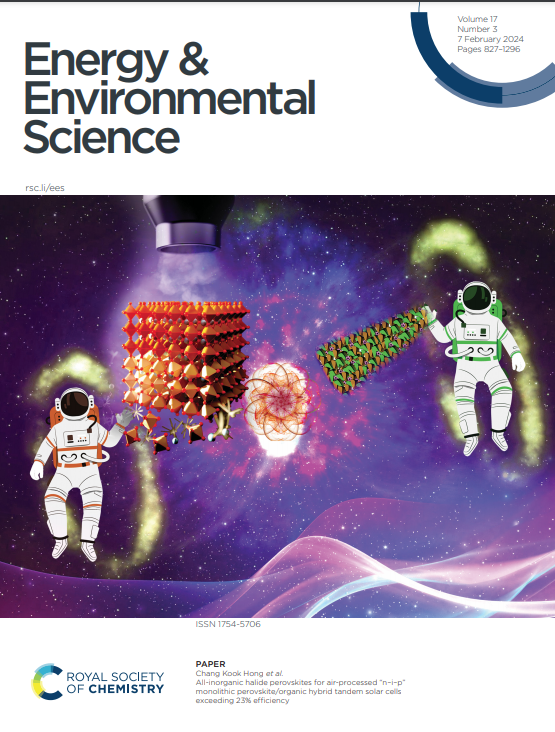原位聚合氟化凝胶聚合物电解质溶剂化结构调控策略研究实用锂金属电池
IF 30.8
1区 材料科学
Q1 CHEMISTRY, MULTIDISCIPLINARY
引用次数: 0
摘要
开发稳定的锂金属阳极和高压阴极的电解质对于下一代锂金属电池(lmb)至关重要。原位聚合凝胶聚合物电解质(GPEs)由于其独特的刚柔结构和优越的界面接触,在高能量密度lmb中具有显著的优势。然而,gpe的溶剂化结构仍未得到充分研究,这是至关重要的,因为它显著影响离子传输和界面稳定性。在这里,我们将氟化聚合物骨架TF引入高浓度醚基液体电解质(HCE)中作为伪稀释剂,具有低的Li +解溶障碍和通过-CF 3基团以非配位方式调节Li +溶剂化结构的离子传输平衡。TF+HCE的弱溶剂化结构促进了均匀沉积,同时有利于形成坚固、富无机的固体电解质界面(SEI)/阴极电解质界面(CEI)。因此,TF+HCE在30°C时表现出高离子电导率(4.02 mS cm⁻¹),并支持在Li||Cu电池中以2 mAh cm -2 300次循环和1 mAh cm -2 1000次循环的长期循环(CE≥98.96%)。此外,在Li||NCM811全电池中,与低锂(45 μm)和高面积容量(2.09 mAh cm - 2)组装后,可以在4.4 V高压下稳定循环。值得注意的是,在高速率(2℃~3℃)下,超过500次循环,容量保留率≥80%。此外,在袋状电池中可以实现465.63 Wh kg(⁻¹)的高能量密度。本文章由计算机程序翻译,如有差异,请以英文原文为准。
Toward Practical Lithium Metal Batteries via Solvation Structure Regulation Strategy in In-Situ Polymerized Fluorinated Gel Polymer Electrolytes
Developing electrolytes that enable stable lithium metal anodes and high-voltage cathodes is critical for next-generation lithium metal batteries (LMBs). In-situ polymerized gel polymer electrolytes (GPEs) offer notable advantages in high-energydensity LMBs due to their unique rigid-flexible structure and superior interfacial contact. However, the solvation structure of GPEs remains underexplored, which is crucial as it significantly influences ion transport and interfacial stability. Here, we employ fluorinated polymer skeletons TF into a high-concentration ether-based liquid electrolyte (HCE) as pseudo diluent, featuring low Li⁺ desolvation barriers and balanced ion transport via -CF 3 group modulating Li + solvation structures in a noncoordinating manner. Weak solvation structure of TF+HCE promotes uniform deposition, while facilitating the formation of a robust, inorganic-rich solid electrolyte interphase (SEI)/ cathode electrolyte interphase (CEI). Consequently, TF+HCE exhibits high ionic conductivity (4.02 mS cm⁻¹) at 30 °C and supports long-term cycling in Li||Cu cells at 2 mAh cm -2 with 300 cycles and 1 mAh cm -2 with 1000 cycles (CE≥98.96%). Besides, when assembled with lean lithium (45 μm) and high areal capacity (2.09 mAh cm⁻²) in Li||NCM811 full cells, it enables stable cycling under high voltage (4.4 V). Notably, over 500 cycles are achieved at high rates (2 C~3 C) with ≥80% capacity retention. Additionally, a high energy density of 465.63 Wh kg⁻¹ is achieved in pouch cells.
求助全文
通过发布文献求助,成功后即可免费获取论文全文。
去求助
来源期刊

Energy & Environmental Science
化学-工程:化工
CiteScore
50.50
自引率
2.20%
发文量
349
审稿时长
2.2 months
期刊介绍:
Energy & Environmental Science, a peer-reviewed scientific journal, publishes original research and review articles covering interdisciplinary topics in the (bio)chemical and (bio)physical sciences, as well as chemical engineering disciplines. Published monthly by the Royal Society of Chemistry (RSC), a not-for-profit publisher, Energy & Environmental Science is recognized as a leading journal. It boasts an impressive impact factor of 8.500 as of 2009, ranking 8th among 140 journals in the category "Chemistry, Multidisciplinary," second among 71 journals in "Energy & Fuels," second among 128 journals in "Engineering, Chemical," and first among 181 scientific journals in "Environmental Sciences."
Energy & Environmental Science publishes various types of articles, including Research Papers (original scientific work), Review Articles, Perspectives, and Minireviews (feature review-type articles of broad interest), Communications (original scientific work of an urgent nature), Opinions (personal, often speculative viewpoints or hypotheses on current topics), and Analysis Articles (in-depth examination of energy-related issues).
 求助内容:
求助内容: 应助结果提醒方式:
应助结果提醒方式:


